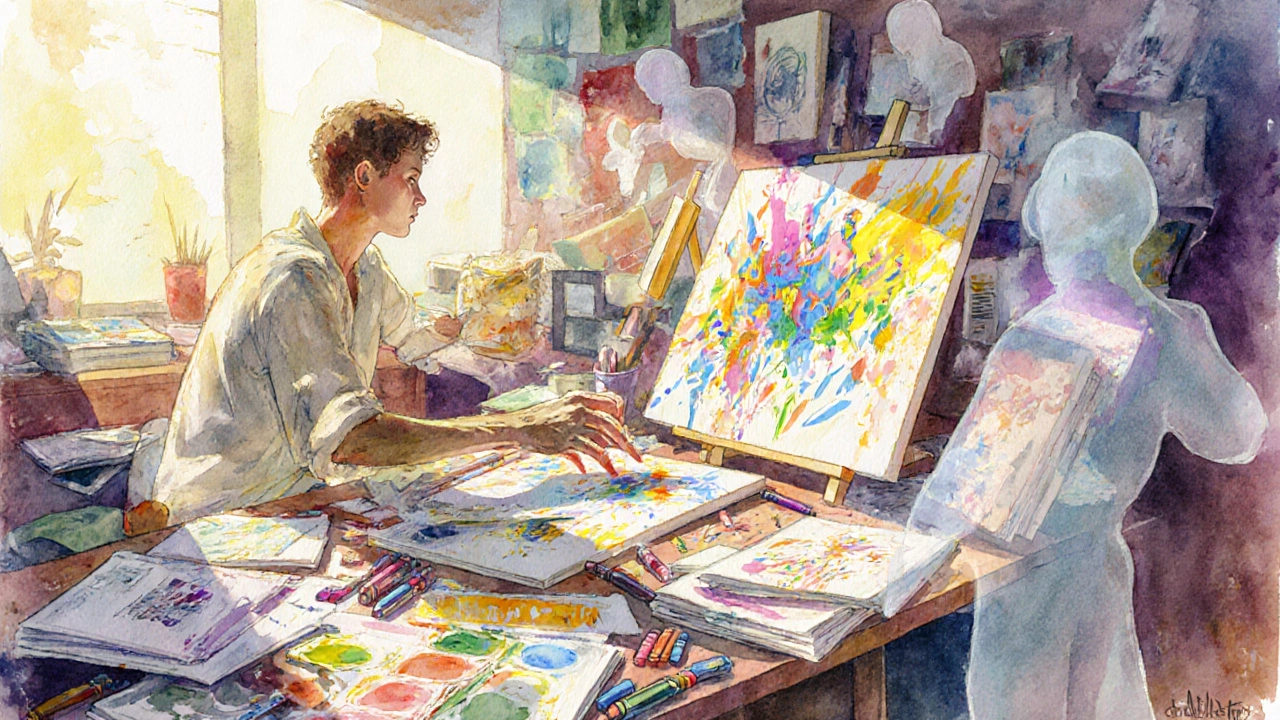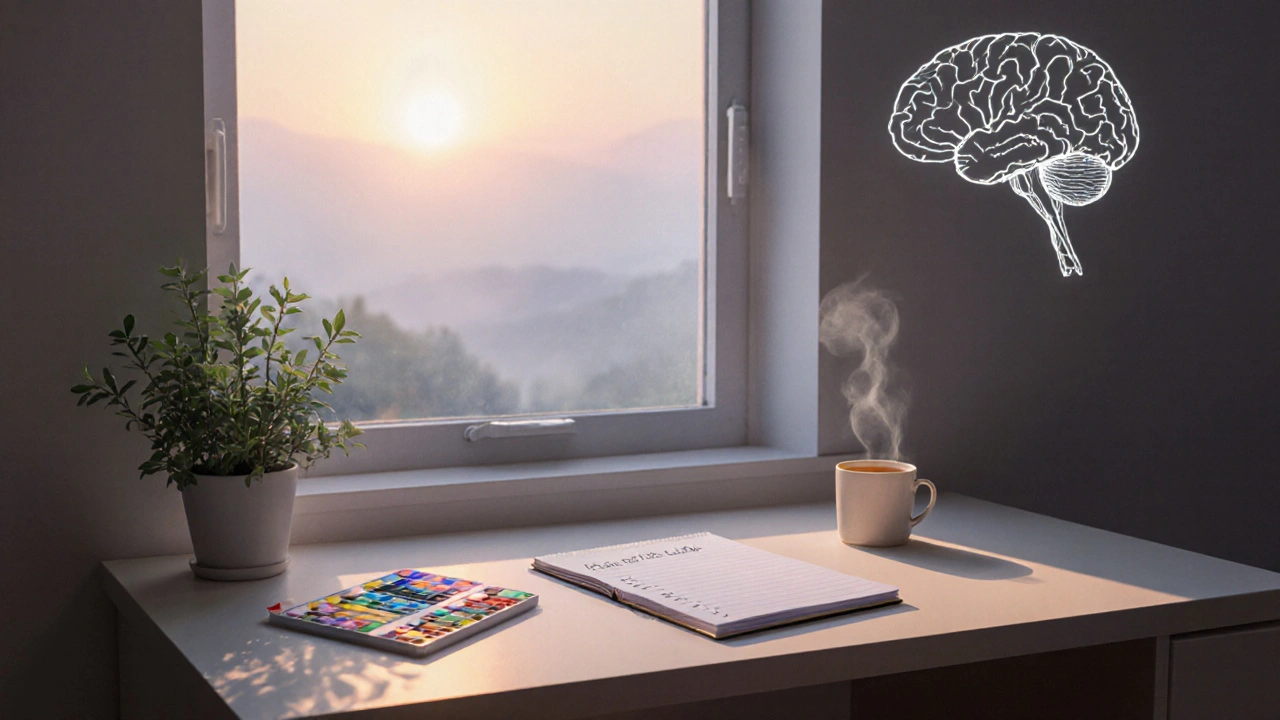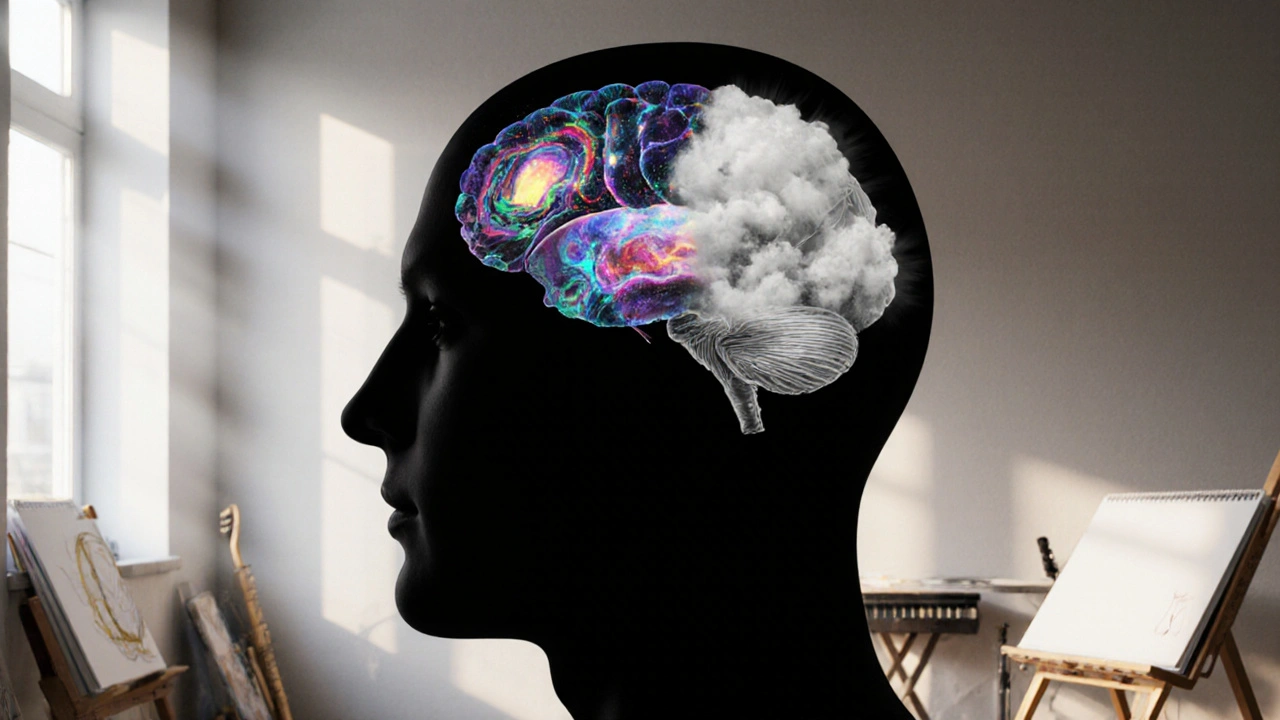Mental Health & Creativity Impact Calculator
Your Creative Profile Analysis
Depression
Strengthened: Rich emotional palette
Pitfall: Loss of motivation
Bipolar
Strengthened: Rapid idea generation
Pitfall: Chaotic output
ADHD
Strengthened: High divergent thinking
Pitfall: Impulsivity
Schizophrenia
Strengthened: Unique associations
Pitfall: Disorganized thinking
Anxiety
Strengthened: Attention to detail
Pitfall: Perfectionism
Quick Take
- Creativity and mental health influence each other in complex, bidirectional ways.
- Conditions like depression, bipolar disorder, and ADHD can boost certain creative traits while also creating challenges.
- Neurotransmitters such as dopamine play a key role in both mood regulation and idea generation.
- Structured practices-mindfulness, routine, and supportive environments-help sustain creativity without harming mental health.
- Artists and professionals can use simple self‑care tricks to protect their wellbeing while staying innovative.
When we talk about Creativity is a mental process that generates original ideas, solutions, or artistic expressions, it often feels like a mysterious gift. Yet science shows clear patterns linking it to mental health. Understanding that link helps you nurture your creative spark while keeping your mind balanced.
What Do We Mean by Mental Health and Creativity?
Mental health refers to emotional, psychological, and social well‑being. It shapes how we think, feel, and act. Good mental health lets you cope with stress, relate to others, and make decisions. When it falters, you might experience anxiety, depression, or other disorders that cloud perception.
Creativity involves two key components: divergent thinking-producing many possible ideas, and convergent thinking-selecting the best one. These skills show up in art, music, writing, science, and everyday problem solving.
Both concepts hinge on brain chemistry, personality traits, and life experiences, which is why researchers keep finding surprising connections.
Scientific Evidence Linking the Two
Over the past two decades, psychologists and neuroscientists have run surveys, brain‑imaging studies, and longitudinal experiments. A 2022 meta‑analysis of 84 studies found that people with mild to moderate depressive symptoms scored higher on measures of divergent thinking than controls. The authors suggested that rumination-repetitive negative thinking-might “loosen” mental constraints, allowing more unusual associations.
On the flip side, severe depression often stalls the creative process, leading to procrastination or total block. The same pattern appears with anxiety: low‑level anxiety can heighten focus and detail‑orientation, while chronic anxiety overwhelms the brain’s executive functions.
Neurotransmitter research highlights dopamine’s dual role. Dopamine spikes during reward anticipation, which fuels both mood elevation and the novelty‑seeking drive essential for creative bursts. Conditions that dysregulate dopamine, such as ADHD, tend to produce high idea fluency but also impulsivity.
Brain imaging shows overlapping networks. The default mode network (DMN), active during mind‑wandering, lights up during day‑dreaming and also when people with depression report “escaping” into imagination. The executive control network (ECN) helps shape those raw thoughts into usable output; it’s often under‑active in mood disorders, explaining why some creative ideas never reach completion.

How Specific Mental Health Conditions Influence Creativity
Below is a quick guide to five common conditions and the creative traits they tend to amplify or suppress.
| Condition | Strengthened Creative Trait | Potential Pitfall |
|---|---|---|
| Depression | Rich emotional palette, deep metaphorical thinking | Loss of motivation, difficulty finishing projects |
| Bipolar Disorder | Rapid idea generation during hypomanic phases | Chaotic output, burnout after depressive episodes |
| ADHD | High divergent thinking, willingness to experiment | Impulsivity, scattered focus, missed deadlines |
| Schizophrenia | Unique perceptual associations, novel symbolism | Disorganized thought patterns, difficulty with coherence |
| Anxiety | Attention to detail, refined craftsmanship | Perfectionism, fear of sharing work |
Notice the recurring theme: many conditions add a “spark” of originality but also bring barriers that stop the spark from becoming a flame.
Leveraging the Positive Side While Guarding Against Risks
Here are three evidence‑based strategies that let you ride the creative wave without sinking into a mental‑health slump.
- Structure the freedom. Set a regular schedule-15‑minute idea sprints followed by a 5‑minute reset. The routine anchors mood swings and prevents endless rumination.
- Use the “flow state” intentionally. Flow state is a deep immersion where self‑criticism fades. Trigger it by matching task difficulty to skill level and removing distractions (phone off, quiet space).
- Practice reflective closure. After a creative burst, write a brief “what worked / what didn’t” note. This bridges the DMN’s free‑form ideas with the ECN’s organizing power, reducing the chance of unfinished projects.
These habits also boost neurotransmitter balance-regular exercise raises dopamine and serotonin, while mindfulness steadies cortisol, the stress hormone that can choke creativity.
Practical Self‑Care Tips for Artists and Innovators
If you identify with any of the conditions above, try these day‑to‑day actions.
- Set a “creative limit”: decide on a maximum number of ideas per session to avoid overwhelm.
- Schedule “mental health check‑ins” with a therapist or trusted peer, especially after intense creative periods.
- Keep a simple journal of mood and idea quality. Over weeks you’ll spot patterns (e.g., best ideas appear after a good night’s sleep).
- Incorporate art therapy techniques like collage or free‑drawing to process emotions without judgment.
- Prioritize sleep. REM cycles consolidate emotional memories, turning raw emotional material into refined artistic concepts.
Remember, the goal isn’t to erase the mental‑health influence-those quirks often give your work its edge. It’s to create a safety net so the edge stays sharp, not broken.
When to Seek Professional Help
Creativity can mask underlying distress. If you notice any of these red flags, consider professional support:
- Persistent feelings of hopelessness that linger beyond creative projects.
- Substance use escalating to cope with artistic pressure.
- Self‑harm thoughts tied to perceived creative failure.
- Inability to maintain basic daily routines (eating, hygiene) due to artistic immersion.
Therapists trained in creative arts therapies can blend talk therapy with expressive activities, offering a tailored pathway to both mental‑health stability and artistic growth.

Frequently Asked Questions
Does anxiety improve artistic detail?
Mild anxiety often heightens focus on fine points, so many artists produce highly detailed work. The downside appears when anxiety becomes chronic, leading to perfectionism that stalls completion.
Can medication dull my creative spark?
Some antidepressants, especially SSRIs, may flatten emotional intensity, which some creators interpret as reduced inspiration. However, many report greater consistency and less burnout. Adjustments with a psychiatrist can find a balance.
Why do I get ideas at night but can’t act on them?
Nighttime triggers the default mode network, fostering free association. Without the executive control network’s activation (which spikes with daylight cues), ideas stay abstract. Keeping a notebook beside the bed bridges the gap.
Is there a link between bipolar disorder and artistic fame?
Historical data shows a higher proportion of famous artists diagnosed with bipolar or cyclothymic traits. The manic phases boost productivity, while depressive periods fuel depth. Still, fame is multifactorial and not guaranteed.
How can I protect my mental health while pursuing a creative career?
Combine regular self‑care (sleep, nutrition, movement) with structured creative habits, set realistic deadlines, and seek community support. Professional help is key if mood swings or anxiety become overwhelming.
Understanding the dance between mental health and creativity doesn’t turn the mystery into a magic formula, but it gives you tools to stay inspired and resilient. Whether you’re a painter, writer, coder, or problem‑solver, paying attention to your mind’s rhythms can turn a fleeting spark into lasting brilliance.

